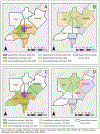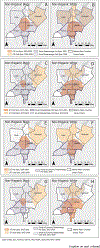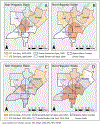Mapping gentrification, segregation, rental cost burden and sexually transmitted infections in Atlanta, Georgia, 2005-2018
- PMID: 39615966
- PMCID: PMC11609406
- DOI: 10.1016/j.sste.2024.100680
Mapping gentrification, segregation, rental cost burden and sexually transmitted infections in Atlanta, Georgia, 2005-2018
Abstract
Racial disparities in sexually transmitted infections (STIs) in the United States have been linked to social inequities. Gentrification instigates population-level shifts in housing markets and neighborhood racial/ethnic composition in ways that may impact the spatial distribution of STIs. This study assessed overlap in clusters of STIs, gentrification, social and economic disadvantage, and rental cost burden in Atlanta, Georgia, between 2005 and 2018. Overlap between gentrification and STIs among Black people was greater than that observed for the overlap between gentrification and STIs among White people. Overlap of STIs with social disadvantage and rental cost burden was more prominent among White people than Black people over time. Additional investigation into the factors behind the spatial dynamics observed in this study, and explanations for their variation by race, are necessary to inform where place-based efforts are targeted to reduce racial disparities in STI transmission in gentrifying cities.
Keywords: Gentrification; Health disparities; Sexually transmitted diseases; Social polarization; Spatial statistics.
Copyright © 2024 Elsevier Ltd. All rights reserved.
Conflict of interest statement
Declaration of competing interest The authors have no relevant financial or non-financial interests to disclose.
Figures





References
-
- Adimora AA, Schoenbach VJ, 2005. Social context, sexual networks, and racial disparities in rates of sexually transmitted infections. J. Infect. Dis. 191 (Suppl 1), S115–S122. - PubMed
-
- Alexander M, 2011. The new JIM crow. Ohio St. J. Crim. L 9, 7.
-
- Berube A, 2018. City and Metropolitan Income Inequality Data Reveal Ups and Downs Through 2016. Brookings Institution, Washington, DC.
MeSH terms
Grants and funding
LinkOut - more resources
Full Text Sources
Medical

